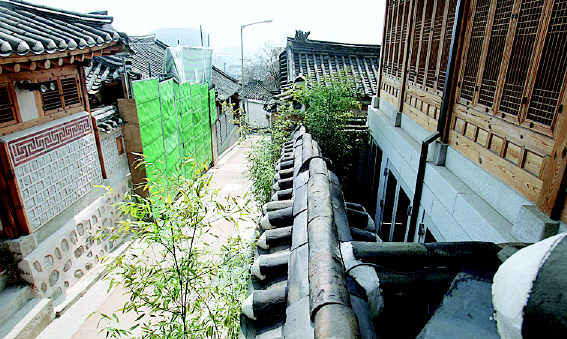 |
Gahoe-dong 31-95 / 가회동 31-95 |
In Jongno-gu Gahoe-dong No. 31 area, one tile-roofed house stands out noticeably in a row of hanoks that sit shoulder to shoulder. Most hanoks are covered by a traditional wall that ends just below the cheoma (the underside of the roof exposed outside), but the majority of this house rises above the wall. The first floor of the building is a concrete construction and the hanok rests atop a second floor. In 2004, a traditional hanok was demolished and replaced by this house, whose construction was subsidized by 30,000,000 won in grants-in-aid and 20,000,000 won in loans provided by the 'Bukchon Hanok Village Restoration Project' initiated by the Seoul Metropolitan Government in 2000. In Kahoi-dong No. 31 zone alone, there are 4 such concrete houses with hanoks resting on top.
There has been nonstop criticism among residents about these 'deformed' hanoks which are appearing throughout Bukchon. "These new hanoks are a sham. They receive financial aid from the Seoul city government and lack the most basic structure of real traditional hanoks," said Choi Geum-ok, a resident who has lived in the Bukchon hanok village for 20 years. "The Hanok village restoration project is, in fact, ruining the hanoks."
Kim Woo-sung, director of the Seoul Metropolitan Bukchon Project, said, "Although there is some truth to the assertion that the original form of these hanoks should be preserved, there is no legal way to prevent remodeling of the interior or extending the house to 2 stories because these houses are not cultural properties." He added, "Even if the owner of a house was encouraged to preserve the outward appearance of a house voluntarily, some compromise is inevitable."
Located between Gyeongbok Palace, Changdeok Palace
and the royal ancestral shrine, the Bukchon district has been a famed
place of residence for high-ranking officials since the Joseon dynasty.
The houses that remain in Bukchon to this day have mostly been renovated
around the 1930s.
Yoo Sin-Jae, writer, ohora[at]hani.co.kr
Translated from the Hankyoreh Daily News : 2007-03-27
Also look at this page and this
![]()